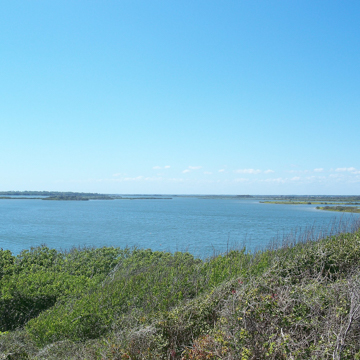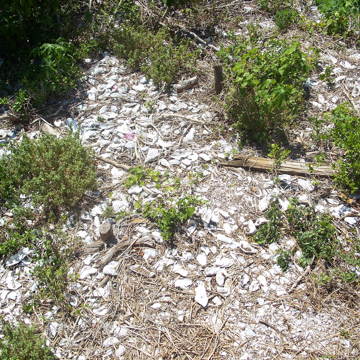At nearly 40 feet high, Turtle Mound is one of the largest shell middens (mounds) in Florida. Constructed over the course of more than 500 years and last used by members of the native Timucua Tribes, the midden is located along the Atlantic coast, on Apollo Beach, just south of New Smyrna Beach on the Canaveral National Seashore. The site was estimated to have once comprised two pyramidal towers roughly 75 feet in height. It remains the tallest pre-Columbian structure in Florida and the third tallest in eastern North America, after Monks Mound in Cahokia, Illinois, and the no longer extant Troyville earthworks in Louisiana.
With recent archaeological findings showing that the first evidence of human habitation on the Florida Peninsula dates to 14,600 years ago, this midden was a relatively recent addition to the built environment created by Native Americans in the region, and was one of the last to be completed before the arrival of the Spanish in 1513. The mound was first mapped in 1605 by Spanish explorer Alvaro Mexia.
Constructed almost entirely of shells with animal bones and pottery intermixed, Turtle Mound provides evidence of the connection of the Timucuan diet with seafaring, as early accounts suggest, and the construction of what was an important landmark, whose height made it visible from miles out at sea on the northeastern Florida coast. During the colonial period, Turtle Mound, known then as Surruque, continued to serve as a navigation marker for Spanish seafarers for centuries.
Turtle Mound was one of many similar shell middens constructed by the Timucua along Florida’s Atlantic coastline. Most have been excavated and the shells used for road fill over the course of the nineteenth and early twentieth centuries. The survival of Turtle Mound is its relatively remote location, nestled along the coast on a narrow strip of land bounded on the west by the northern portion of Mosquito Lagoon. This unique location between the ocean and lagoon, combined with the heat-absorbing properties of the building materials within the midden, make it the northernmost habitation of several species of plants known only to grow much further south along the coastline.
Today Turtle Mound is both an active archaeological site and a tourist destination for visitors of the Canaveral National Seashore.
References
“Archaeology Magazine: Travel Guide to North America.” Archaeology 40, no. 3 (May/June 1987): 1-16.
Folsom, Franklin, and Mary Elting Folsom. American’s Ancient Treasures. Albuquerque: University of New Mexico Press, 1993.
Milanich, Jerald T. and Nara B. Milanich. “Revisiting the Freducci Map: A Description of Juan Ponce DeLeon’s 1513 Florida Voyage?” The Florida Historical Quarterly 74, no. 3 (Winter 1996): 319-328.
Morgan, William N. Precolombian Architecture in Easter North America. Gainesville: University Press of Florida.




